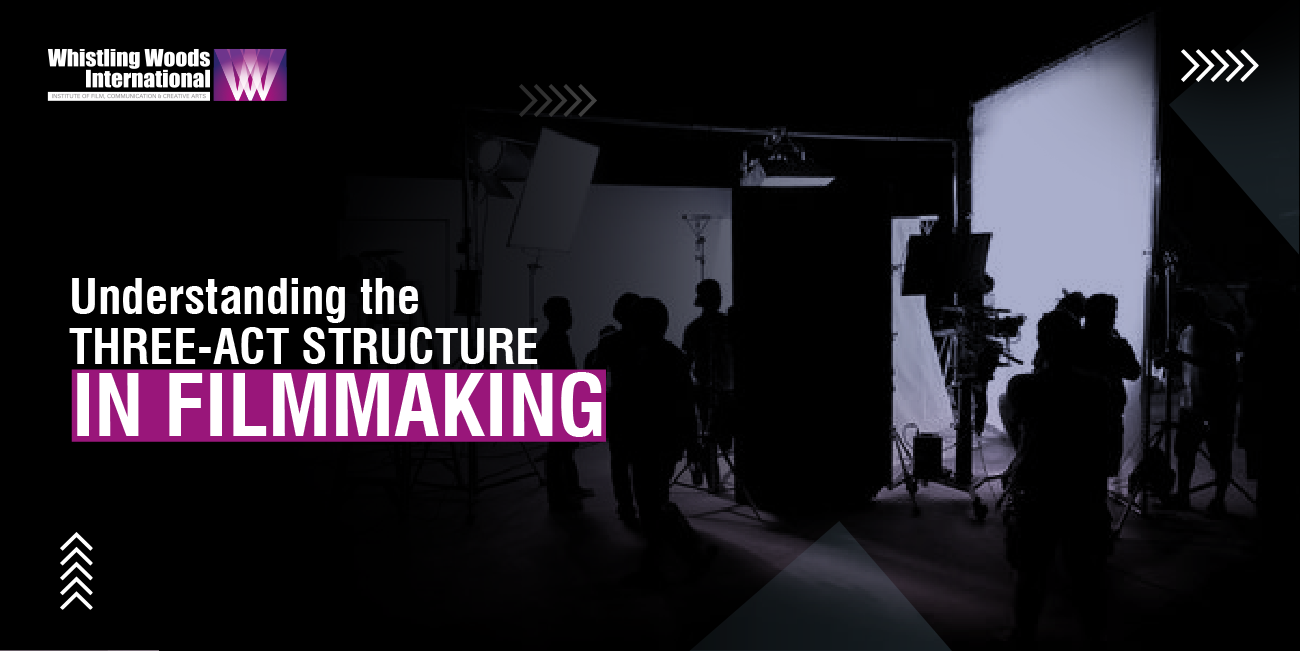For every scriptwriter aiming to craft an exceptional film, delving into the intricate realms of storytelling is an imperative journey. At the heart of this lies a fundamental principle that holds the power to elevate narratives from mere chronicles to captivating sagas – the venerable three-act structure in filmmaking.
Both new and experienced filmmakers see this structure as the foundation for creating captivating stories. Just like a blueprint shapes a magnificent building, the three-act structure guides the smooth flow of the story, characters, and feelings, turning a regular story into an extraordinary cinematic journey.
In this blog, we talk about the intricacies of this storytelling framework, getting into its layers and significance in shaping the essence of cinematic art and your filmmaking career in India.
What Is The Three-Act Structure In Film?
It is a foundational framework employed in storytelling, particularly in the realm of filmmaking, to create a coherent and engaging narrative arc. It serves as a roadmap for writers and filmmakers to effectively structure their stories, guiding plot progression, character development, and emotional resonance.
- Act 1
Act 1, the initial phase of this structure, lays the groundwork for the narrative. It introduces the audience to the story’s setting, characters, and central conflict. This act catalyses the story forward by establishing the characters’ goals, motivations, and the challenges they must overcome. Act 1 often concludes with a turning point or an inciting incident, a pivotal moment that catapults the protagonist into the heart of the conflict.
- Act 2
Act 2, the most extended segment of the structure, is characterised by rising tension and escalating stakes. Here, the conflict is developed and deepened, presenting the protagonist with a series of obstacles and trials that test their resolve and capabilities. This act is also marked by a midpoint, a crucial event that shifts the story’s trajectory and often forces the protagonist to confront their limitations or alter their approach. Act 2 culminates in a climax, the highest point of tension and drama, where the protagonist faces their ultimate challenge and must make a critical decision.
- Act 3
Act 3, the final act, focuses on resolving the conflict and providing closure to the story. The climax’s aftermath is explored, and loose ends are tied up. The protagonist’s growth and transformation and the resolution of their internal and external conflicts are showcased. Act 3 concludes with a denouement, a concluding scene allowing the audience to witness the lasting impact of the protagonist’s journey and their world.
The three-act structure’s appeal lies in its ability to provide a balanced rhythm to narratives. It engages audiences by establishing an equilibrium, disrupting it with conflict, and ultimately restoring balance through resolution. This structure doesn’t dictate a rigid formula but rather offers a flexible framework that accommodates a variety of storytelling genres and styles.
Become A Filmmaker: Start Today!
In essence, the three-act structure in films serves as a storytelling compass, guiding writers and filmmakers through the complexities of crafting a compelling and impactful narrative. It empowers them to captivate audiences, evoke emotions, and leave a lasting impression by orchestrating the ebb and flow of tension, anticipation, and satisfaction that characterise a well-crafted story.
In the rapidly evolving field of cinema, attending a screenwriting course can help to master the three-act structure in filmmaking and elevate your writing skills in the film industry. These courses delve deep into narrative techniques, dissecting successful films to understand how the narrative engrosses the audiences. They offer a collaborative space for feedback and discussions, mirroring industry teamwork. Comprehensive curricula cover character development, pacing, and adapting text for the screen.
Whistling Woods International’s School of Filmmaking provides various courses in filmmaking that can help you start your career. Our filmmaking courses in India equip aspiring writers to craft compelling, impactful narratives that thrive within the dynamic realm of cinema.
The courses that we offer:
- BSc in Filmmaking | (3 Years): This comprehensive programme covers screenwriting, direction, cinematography, editing, and more, preparing students for the dynamic filmmaking industry with a focus on technology and innovation.
- MA in Filmmaking with Specialisation | (2 Years): Our balanced approach includes individual and group projects, nurturing teamwork and collaboration skills alongside hands-on filmmaking experience.
- Diploma in Screenwriting | (1 Year): Intensive training in storytelling for passionate screenwriters, offering insights into crafting narratives and understanding the evolving industry landscape.
- MA in Screenwriting | (2 Years): Advanced two-year programme fostering professional screenwriters, honing writing skills for cinema, television, and OTT platforms across various genres.
You can browse further on our website to scroll through the other courses apart from the filmmaking courses in India that we offer.

